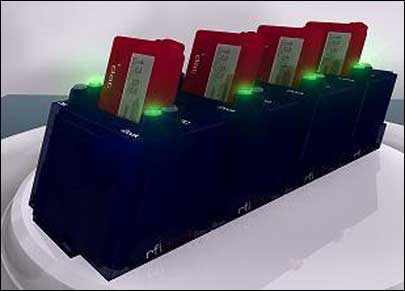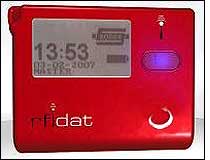Startup company Zeitgroup is launching a passive RFID-enabled system designed to help businesses monitor their workforce by measuring and tracking employee attendance, productivity, workflow and more. The system, for instance, can monitor the amount of time it takes automotive mechanics to service vehicles. It can also track where and when security personnel inspect the buildings or grounds they are hired to guard.
The system employs passive 125 kHz RFID tags compatible with EM Microelectronic‘ EM4102 tags. Available in a variety of form factors, the tags can be affixed to areas or assets as required, depending on the specific application. The system also includes an RFIDat battery-powered mobile RFID interrogator, which measures 59 by 44 by 14 millimeters (2.3 by 1.7 by 0.6 inches)—about the size of a credit card—and weighs 38 grams (1.3 ounces).
Employees can wear the RFIDat reader around their necks or on their belts, or place it within their pockets. Each interrogator has its own embedded 125 kHz tag bearing a unique ID number, used to identify the worker carrying it, and features an LCD and a button that staff members can push to clock in and out as necessary. Each reader can store up to 8,000 transactions, or tag reads. The rechargeable battery within the device typically lasts from 10 months up to a year, depending on the number of reads (based on approximately 20 tag reads per day).
Companies can use the system for a variety of applications. To measure how long it takes auto mechanics to service vehicles, for example, a firm could affix the tags to vehicles as they enter the auto shop, explains Carlos Guzman, a partner with Zeitgroup. When a mechanic begins working on the tagged vehicle, he positions his RFIDat reader to within about 3 centimeters (1.2 inches) of the vehicle’s tag, then pushes the button on the interrogator. This directs the device to scan the tag and cull its unique ID number. The RFIDat also time-stamps the read, and stores the transaction in its memory. Upon finishing his work, Guzman says, the mechanic repeats the process by placing the reader near the vehicle’s tag and pushing the button once more.
Similarly, to document a security guard’s rounds, a company could affix tags to walls or doorways in various sections of a building. Upon reaching a doorway or wall tag, the guard can place the RFIDat near the tag and press the button. The interrogator records each tag’s unique ID number, creating a trail that documents where and when the guard has patrolled.
Also included in Zeitgroup’s system is a docking station, known as RFIDock, for recharging an RFIDat reader’s battery and downloading the collected tag data and time-stamps, as well as the unique ID number of the device’s embedded RFID tag, which identifies the employee using that reader. The stations—which come with either one, two or four slots in which interrogators are placed—can store up to 16,000 tag reads, and can be connected to a PC via an RS-232/Ethernet cable, in order to transfer information downloaded from the readers.
In addition, Zeitgroup offers custom software called ZeitCom, which includes a MySQL 5 database and is compatible with the Microsoft Windows 98, 2000, XP and Vista operating systems, as well as the MAC Leopard 10.5. A company can install the software on a computer and utilize it to manage the RFIDat’s communications and configurations, such as inputting and correlating employees’ names with the ID number of each RFIDat’s embedded RFID tag. The software also serves as a program for compiling and reviewing the data.
A business also has the option of assigning one of its RFIDat interrogators to serve as the master. Employees can simply download their tag reads to that master by placing their readers near it and pressing the button, thus initiating the devices to pass along the data to the master. At the end of the day or week, the master can then be taken back to an office and placed into a docking station.
“The reader is very durable,” Guzman says, “because it is sealed and there are no connectivity slots in which dust can get in. It’s easy—there’s only one button to press, so anyone can use it.” The reader’s LCD displays the employee’s name, the date and time, and the number of tag reads that individual has made since starting a shift (the RFIDat resets to zero upon either communicating the tag reads to a master or downloading them to a dock). When a worker presses the RFIDat button to initiate a read, a blue light on the device begins blinking, indicating the interrogator is performing a tag read. If the employee holds the button down for three seconds, the reader’s LCD will display the ID number of the last tag read, along with the time that reading was taken.

Zeitgroup’s solution is designed to measure and track employees whose job functions require them to be on the move. But because the RFIDat reader requires no cabling or external power to operate, Guzman says, it is also ideal for mobile job sites, or those under construction.
“In a construction site, where it is very difficult to have wiring, we provide you with a system, and you don’t need electricity,” Guzman states. “You just have to have the RFIDat charged. We call it ‘goodbye fixed terminals.’ With this solution, you can have an RFID reader in every employee’s hands, and you can monitor when every employee comes to work, and what tasks they are performing.”
Guzman and fellow partner Juan Carlos Abello first got the idea to launch Zeitgroup after taking a vacation in Italy, approximately two years ago. There, they met Antonio Borsetti, founder of Socos, an Italian RFID provider. Impressed with Socos’ product portfolio, which included a version of the RFIDat reader sold only to distributors, Guzman and Abello wanted to bring the product to the U.S. market, so they drew up a business plan to become one of Socos’ distributors. But the two Americans also thought the system could use some updated software applications. “Borsetti was interested in opening a U.S. office,” Guzman says, “and as we progressed with our business proposal and strategy, he liked the strategy so much that he has decided to merge Socos into Zeitgroup.” Now, the company has two branches: Zeitgroup Italy, in Rimini, which Borsetti operates, and Zeitgroup USA, in Miami.
In addition to offering the solution through distributors, Zeitgroup now sells the system directly to companies as well. In an effort to better serve end users, Zeitgroup is developing the ZeitCom software—designed simply so distributors and resellers can customize as per a client’s needs—into targeted applications designed for specific markets and functions. The firm now offers ZeitTask, which helps businesses utilize the RFID tag reads and timestamps to measure and analyze labor productivity. What’s more, the startup company is also working on ZeitFlow, aimed at helping companies better understand their workflow.
In a typical installation of 52 RFIDat readers—two of which are designed to be used as masters—and a single two-slot dock, the system costs an end user approximately $280 for each reader. However, Guzman notes, pricing depends on configuration, as well as on whether any customization is required.


